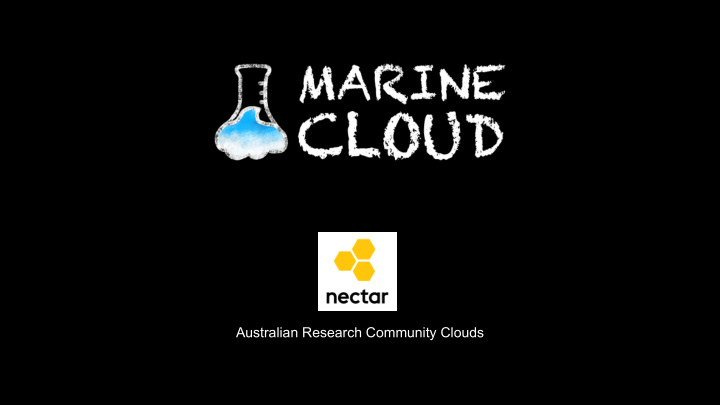



Australian Research Community Clouds
10 Second Summary To provide marine scientists and students a robust framework of tools and resources with easy access to open data in a standard environment. Designed to reduce the time for tool and code preparation as well as the data discovery process.
The two main areas of focus 1. National Service for annotation and analysis of underwater imagery and video 2. A standard working environment in the cloud (Available from a web browser) (Secondary overarching focus: Access to Data)
National Service for annotation and analysis of underwater imagery and video Two elements of the service: ● GlobalArchive ● SQUIDLE+ A repository for annotation data A platform for exploration, management and annotation of ○ Online prototype http://146.118.103.240 georeferenced images & video Conceived by Tim Langlois from UWA, ○ ○ Online prototype http://203.101.232.29 created by Ariell Friedman from Greybits ○ Conceived and created by Tim Langlois from UWA
GlobalArchive Provides flexible import of information associated with sampling campaign Have made changes in leading software to enable complete archive of stereo image annotation
GlobalArchive Organisation of multiple Campaigns by Projects With option to make data sets Open Access
GlobalArchive Flexible Collaborations between users to share Campaign data
GlobalArchive Organises data by sampling methods Flexible format will allow historical and modern datasets from any method to be imported
GlobalArchive Standardised data tables allow querying of multiple campaigns Proposed user secured scripted interface (R and Python) will allow for easy analysis and streamlined data interpretation
GlobalArchive Proposed interactive web application Takes advantage of standardised data format Interrogate monitoring data
2. Standard working environment in the cloud? A virtual machine in the cloud, offering a remote desktop environment in the browser. The cloud scalable to demand, supporting collaboration. Integrated with AAF Three main areas of focus: Tools, Support (Resources) and Data.
● Tools: ○ R-Studio, Jupyter, Standard Packages, Ponopoly, NetCDF viewer etc. ○ Potential to push to HPC services for larger jobs (Stretch) ○ Push to HPC (Stretch). ● Support (Collated Resources) ○ Working sample code using real data. ○ Complete end-to-end examples of research where available. ○ Relevant contact information for National support.
Data: ● Access to open data, AODN, TPAC, IMAS, NCI. ○ Focus on well structured data, with modern API’s ■ WFS. ■ WPS. ■ THREEDS / OPeNDAP. ● Shared and Public spaces for local data and collaboration. ○ Local datasets (TPAC, IMOS, IMAS). ○ Intermediate datasets, private and embargoed. ● Personal persistent home storage.
Who is involved: NeCTAR University of Tasmania IMOS TPAC (Tasmanian Partnership for Advanced Computing) TURN University of Queensland UWA Greybits Engineering Brendan.Davey@utas.edu.au Roger.Proctor@utas.edu.au
Recommend
More recommend